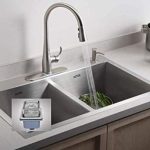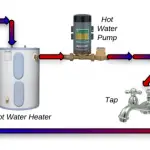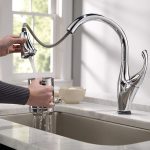The personal well at your home would provide you with a better financial and health-related advantage when you compare it to the municipal water supply. However, the well water does have its own problems. One of the issues that you are likely to come across would be the water pressure (or lack of it) on the well water.
So, How to increase the well water pressure?
A few best options to help you how to turn up the water pressure on the well would be to adjust the pressure tank settings, using a pump with a higher flow capacity, upgrade to a constant water pressure, and install a water pressure booster pump. Applying any of these fixes as per your preferences can help you increase the water pressure on well water.
How to Turn Up Water Pressure On a Well?
If your water supply comes to your home from a well, I would suggest you opt for the different options as per your preferences and exact individual requirements.

Adjust the pressure tank settings
Almost every residential well comes equipped with pressure tanks. These tanks are used for controlling the pressure of the water from the well to your home. The average pressure you will receive from the municipal water supply would be around 60 PSI. The pressure maintained for the well water tanks would be just around 28 PSI. However, you can easily adjust the water pressure.
The additional tank pressure would be around 20/40, 30/50, and 40/60 PSI. It may be a good idea to increase the pressure to 40/60 PSI.
Buy a pump with the higher flow capacity
If you find your pump is adjusted to the highest setting, and yet do not receive the best water pressure, it may be due to your water pump. Each of the different well pumps comes with a different flow rate, or flow capacity, rating. In case the flow rate is too low, you may need to look for a pump with a higher pressure level.
The flow rate of a water pump is measured in gallons per minute. If you increase the flow rate of your pump by upgrading to a new one, it can be helpful in increasing the water pressure at your home.
Move to a constant pressure system
Yet another best option that we would recommend would be to invest in a constant pressure system. The traditional well system may not work as expected if your well water receives frequent water fluctuations. That is why we would recommend upgrading to the constant pressure system.

A traditional pressure system may not stop the water pressure to fluctuate more than 20 PSI. The constant pressure does not allow the water pressure to drop by more than 2 psi. If the pressure system notices any fluctuation, the pump will increase the pressure instantly.
Go for a water pressure booster pump
Yet another excellent way to help you in increasing the water pressure in well water is to install the water pressure booster pump. You can simply add the system to your home plumbing system. The booster pump would be a good pick if you find the water pressure is too low on the top floor of your home.

The booster pumps are operated by electricity and thus can be a good pick with the motors and impellers in increasing the water pressure even on the top floor of the building.
Check the air-fill valve
Test the air fill valve with the requisite gauge. The pressure should ideally be in the range of 40 to 60 PSI. if you find that the pressure falls outside this normal range, you would need to adjust the pressure switch.
Key Takeaways
A few facts about the water pressure worthy enough to know can include:
- The water flow in the taps and faucets is caused due to the pressure of the water. The lack of proper water pressure will leave the taps dry. In the case of most of the well water pumps, it is the well pump that provides the requisite pressure.
- Different pumps offer different flow capabilities. The overall flow is related to the capacity of the pump. If you have a large household, and your pump is not capable of a higher flow rate, you will experience trickles down your faucet.
- If you are receiving water from a utility, the location of your home and the age of the utility will have an impact on the water pressure that you would be able to get access to. in such a scenario, you may need to install the booster pump and pressure tank.
What Causes Low Water Pressure in a House With a Well?
Some of the primary causes for the low water pressure in a house with a well can be the build-up in the pipes and even the sedimentation in your plumbing system. Some other reasons can be the malfunctioning pressure regulators and possible blockages in the plumbing system.
Some of the causes for the low water pressure in a well water can be a few of the following reasons.
A faulty pressure well tank
A faulty pressure tank can be the prime reason for the a drop in the water pressure. It can be a good idea to check the air pressure in the tank. You can use a typical pressure gauge for checking the pressure inside the well.
Clogged pipes
The ground water and the well water is filled with sediments and can thus result in causing the sedimentation in the water plumbing. The debris and the limescale in the pipes can be what is obstructing the water supply or even reduce the water pressure from your well.

Check out all the faucets and showerheads for any sort of blockage. If you find any sort of clogging in these sections of your home, it can be a clear indication of a clogged piping system. It would be advisable to get the piping system checked by the licensed local plumber. You can even consider using a water softener system for preventing the limescale formation due to hardware.
What is Good Water Pressure For a Well?
Most of the water pressure systems come with a default setting for a pressure setting for 30/50. The pressure on the tank should ideally be at 28 PSI. in case your tank has a 40/60 pressure switch, you would find the ideal pressure to be at 38 PSI.
There is no specific GOOD PRESSURE that you would need to configure. The good pressure would largely be dependent on different parameters.
- If you have a small family of two to three people, and you have your well located close enough to your home, you can configure the pressure settings at 20/40 or 30/50. But if the well is located far away from your home, a high pressure would be the need of the hour. In such a scenario, you can configure the setting at 40/60 psi.
- For a large home with two to three people, and if your home is located close enough to the well, you will need a pressure of 30/50 or so. However, if you have more than 6 to 8 people, make sure that you have a pressure set at 40/60 psi. in such cases, you will need to install a water pressure booster.
What Factors Should You Take Care of When Handling Water Pressure From Well?
The factors that dominate the water pressure would include:
- The distance of the well from your home: if your home is located close enough to the well, you will need a low pressure setting on your home water system. In case your home is located far away from the well, you will need to use a high-pressure setting on your well water.
- The number of faucets that work simultaneously: The number of faucets running simultaneously can also have a say on the water pressure from your well water. If you have multiple people living in your family, you will need a high pressure to handle the load effectively.
- The number of stories in your home: multi-storey homes will require a higher water pressure. If you have water treatment systems in your home, the high-pressure water supply will ensure that the water pressure will reach the upper stories.
- The number of appliances in your residence: More appliances in your home will mean that the water pressure is impacted to a considerable extent. The lower pressure will result in poor functioning of these machines.
Can Your Well Water Reach High Pressure?
Having too much pressure is quite rare and can result in faulty pressure settings in your system. It is advisable to ensure that the cut-off valve is set to 80 PSI or below.
Too much high pressure would seriously harm the appliances and even result in bursting the plumbing system. It can also overwork the plumbing system and make it run over a continuous cycle.
How to reset the pressure switch on well pump?
Resetting the pressure switch on a good pump can help resolve issues with water pressure or pump cycling. Here’s how you can do it:
- Turn off the power supply to the well pump at the circuit breaker.
- Locate the pressure switch, which is typically located near the pressure tank.
- Remove the cover of the pressure switch to access the contacts and adjust the screws.
- Locate the “lever” or “button” on the pressure switch that is used to reset it. It is usually located in the middle of the switch.
- Push down on the lever or button to reset the pressure switch. You should hear a clicking sound when you do this.
- Turn on the power supply to the well pump at the circuit breaker.
- Wait for the pump to turn on and then check the water pressure using a pressure gauge.
- If the pressure is within the desired range, replace the cover of the pressure switch. If the pressure is not within the desired range, you may need to adjust the pressure switch or check for other issues with the well pump system.
Frequently Asked Questions (FAQs)
Conclusion
Relying on well water is quite common in rural areas. It would also be a good option from the health perspective in many cases. But, the well water will invariably result in a change in the water pressure. The low pressure on the well water can be due to several reasons that can include blocked pipes, the issues with then pressure tank, or even clogged aerators. The tips and tutorials outlined in the above discussion should have helped you pick the best picks that you would find much impressive.











Add Comment